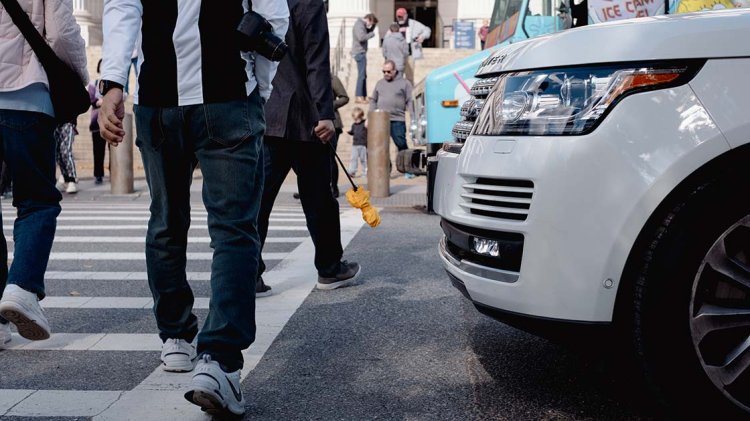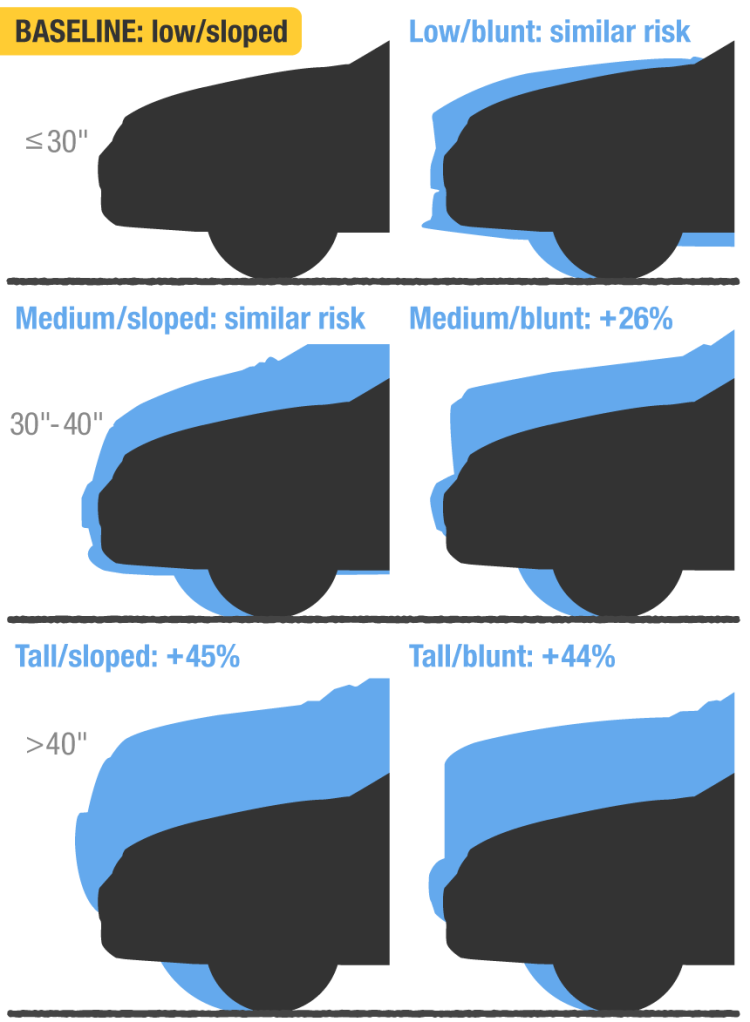Vehicles with especially tall front ends are most dangerous to pedestrians, but a blunt profile makes medium-height vehicles deadly too, new research from the Insurance Institute for Highway Safety shows.
Whatever their nose shape, pickups, SUVs and vans with a hood height greater than 40 inches are about 45 percent more likely to cause fatalities in pedestrian crashes than cars and other vehicles with a hood height of 30 inches or less and a sloping profile, an IIHS study of nearly 18,000 pedestrian crashes found. However, among vehicles with hood heights between 30 and 40 inches, a blunt, or more vertical, front end increases the risk to pedestrians.
Pedestrian crash deaths have risen 80 percent since hitting their low in 2009. Nearly 7,400 walkers — more than 20 people a day — lost their lives in 2021 after being struck by a vehicle. While speeding and poorly designed infrastructure have helped fuel the increase, many safety advocates have also drawn a connection to the growing portion of the U.S. vehicle fleet made up of pickups and SUVs.
Over the past 30 years, the average U.S. passenger vehicle has gotten about 4 inches wider, 10 inches longer, 8 inches taller and 1,000 pounds heavier. Many vehicles are more than 40 inches tall at the leading edge of the hood. On some large pickups, the hoods are almost at eye level for many adults.
To examine the connection between fatality risk and vehicle size and shape, IIHS researchers analyzed 17,897 crashes involving a single passenger vehicle and a single pedestrian. Using Vehicle Identification Numbers to identify the crash-involved vehicles, they calculated key front-end measurements corresponding to 2,958 unique car, minivan, large van, SUV and pickup models from photographs. They excluded vehicles with pedestrian automatic emergency braking systems and controlled for other factors that could affect the likelihood of a fatality, such as the speed limit and age and sex of the struck pedestrian.
Vehicles with hoods more than 40 inches off the ground at the leading edge and a grille sloped at an angle of 65 degrees or less were 45 percent more likely to cause pedestrian fatalities than those with a similar slope and hood heights of 30 inches or less. Vehicles with hood heights of more than 40 inches and blunt front ends angled at greater than 65 degrees were 44 percent more likely to cause fatalities.
While sloping front ends did not reduce the risk posed by vehicles with the tallest hoods, they did make a difference for vehicles with hood heights of 30-40 inches. Compared with low and sloped vehicles, medium-height vehicles with blunt fronts were 26 percent more likely to cause pedestrian fatalities. In contrast, the risk of a fatality was about the same for medium-height vehicles with sloped fronts as for low vehicles with either blunt or sloped fronts.
The researchers looked at several other vehicle characteristics, including the angle of the windshield, length of the hood and angle of the hood. Among these, the slope of the hood had the biggest effect. There was a 25 percent increase in the risk of a fatality for vehicles with flat hoods — those with angles of 15 degrees or less — compared with vehicles with more sloping hoods. That was true regardless of height and front-end shape.
To better understand how vehicles of different geometries injure pedestrians, IIHS examined detailed records from 121 crashes collected by the International Center for Automotive Medicine Pedestrian Consortium. In each crash, the front end of a car, pickup or SUV struck a teenager or adult. The data included detailed crash reconstructions, including information about the motion of the pedestrian’s body during the crash and the nature and severity of their injuries. The reports also included the year, make and model of the striking vehicle and the height of the pedestrian.
The researchers used the same measurements as those used in the larger study to define vehicles with blunt and sloped front ends and tall and short ones. For this study, however, they divided the involved vehicles into only two height groups because of the smaller sample size. Taller vehicles were defined as those with a hood leading edge more than 35 inches off the ground. Shorter ones were those with a hood leading edge 35 inches or less from the ground.
In general, vehicles taller than 35 inches were more dangerous to pedestrians than the shorter ones, mainly because they tended to cause more severe head injuries. Among vehicles taller than 35 inches, those with vertical front ends were more dangerous than those with sloped front ends. Torso and hip injuries from these vehicles were more frequent and severe.
Unlike all other vehicle types, tall and blunt vehicles primarily inflicted torso injuries with their front ends rather than with the tops of their hoods. They were more likely to injure pedestrians by throwing them forward, while tall and sloped vehicles usually rolled them onto the hood of the vehicle first.
Pedestrians who were shorter relative to the height of the striking vehicle also suffered more severe injuries.












